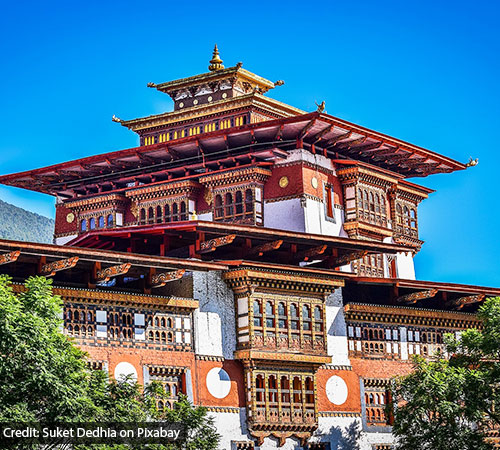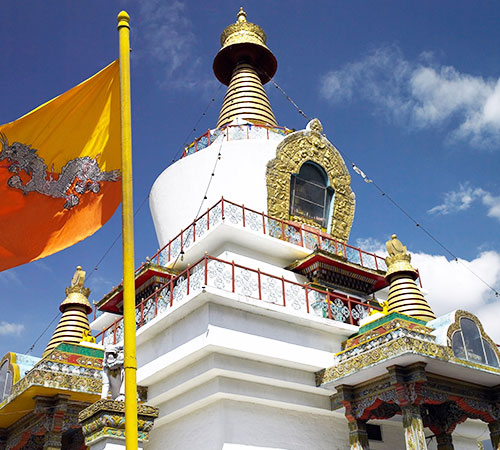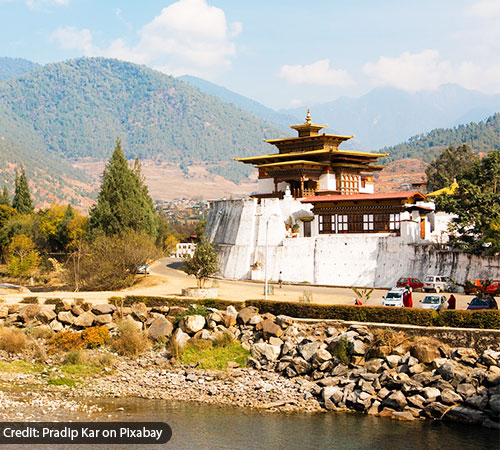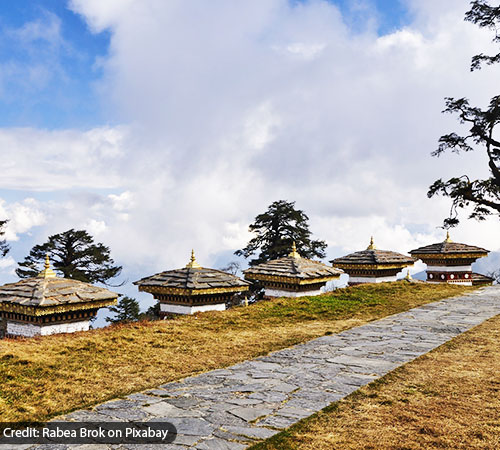![]() Duration
Duration
08 Nights/09 Days
![]() Destination
Destination
BHUTAN
![]() Tour ID
Tour ID
SBT-07
![]() Inclusions
Inclusions
Detailed Itinerary
On arrival at Bagdogra Airport/ NJP / Hasimara / New Alipuduar station, you will be received by our executive, who will be waiting outside for receiving you and proceeding for Phuentsholing, through the lush green as well as most beautiful Tea garden in Dooars . On arrival at Phuentsholing, The most rapidly growing town in Bhutan, check in at hotel, evening scroll in market & Night Stay.
After having done with your breakfast, our office executive will guide you to the immigration to complete the visa formalities and obtain it. After permit done ,we will proceed towards Thimphu, evening scroll in the market and night stay.
After having done with your breakfast , we will start our day with local sightseeing and night stay.
National Textile Museum: National Textile Museum which was opened in June 2001 is worth a leisurely visit to get to know the living of national art of weaving. Changing exhibitions introduce the major weaving techniques, styles of local dress and textiles made by women and men. The small shop features work from the renowned weaving centre in Lhuntshe Dzongkhag, in north-eastern Bhutan.
Tashichodzong: The beautiful medieval fortress/monastery which houses most of the government’s office and King’s Throne room. It is also the summer residence of Je khenpo, the Chief Abbot. The fortress is opened from 9am till 5pm during weekends and during weekdays it’s open after 5pm till 6pm.
National Memorial Chorten: It is continuously circumambulated by the faithful, murmuring mantras and spinning their prayer wheels. Construction of this landmark was the idea of Bhutan’s third king, His Majesty Jigme Dorji Wangchuck (“The Father of Modern Bhutan”) who had wished to erect a monument to world peace and prosperity. Completed in 1974 after his untimely death, it serves both as a memorial to the Late King and as a monument to peace.
Folk Heritage Museum: It is one of the oldest traditional houses. This house has been around 150 years old. It once belonged to one of the affluent family. Government has converted the house into museum in 2001 in Thimphu providing visitors and tourists with fascinating insights into the Bhutanese material culture and way of life. The Folk Heritage Museum with a three storied, 19th century traditional house provides you a glimpse of the Bhutanese lifestyle, and artifacts from the rural households. One can come across typical household objects, tools and equipments.
Buddha Point: One of the biggest Buddha in the world. It was constructed through donations from devotees all around the world.
After done with your breakfast , we will start our day with local sightseeing & evening scroll in market and night stay.
National Library: With extensive collection of Buddhist literature mostly block-printed format, the library contains works of several hundred years old literary treasures of Bhutan. It also has a small collection of foreign books. The library has texts relevant to Mahayana Buddhism and a rich collection of lithographs from whence scriptures and prayer flags were printed in the old days. The National Library was established in 1967 to preserve ancient dzongkha and Tibetan texts. This library building was built in 2001.The world’s biggest published book is also in this library. Bhutan, the book weighs 68 kilograms and is over two meters tall.
Changangkha Lhakhang: Situated on a small hill overlooking the Thimphu valley the monastery was built in the 13th century by Lam Phajo Dugom Zhigpo. Children born in Thimphu are taken to this temple because it is considered the spiritual home of the children born in Chang valley.Names such as Tandin Sonam are given from this temple to new born babies taken for blessings from the protector deity Tamdrin.The central statue in the temple is Avaloketesvara, Buddha of compassion, in his manifestation with 11 heads, a thousand hands and eyes; it is built with bronze and plated with gold.
Painting school: It’s a non profitable organization established by government to encourage the youth into the unique arts and crafts.
Sangayang View point (Telecom Tower): Theirs is a wonderful view of thimphu valley from the hillside below the telecommunication tower ,elevation (2685m) high above the tower at the end of the road that branches off from the approach to the youth centre.The complex also houses the board casting studio of Bhutan television. Don’t photograph the telecommunication installation ,but the valley is worth a few snaps .The valley is known as Sangayang and its become the lover’s lane late at night.
Takin Preserve :The Preserve houses the Takin is Unique ,endanger species is found in Bhutan ,Nepal ,China and Bhutan has chosen it as a national animal due to its significance in religion and cultural history.
After having done with your breakfast, we will start our day with a drive to Punakha & sightseeing and night stay.
Punakha Dzong: The Dzong is located at the confluence of the Pho Chhu (father) and Mo Chhu (mother) rivers in the Punakha–Wangdue valley. The source of the Mo chu river is in the northern hills of Lighsi and Laya in Bhutan, and in Tibet. The Po Chu River isfed by glaciers in the Lunana region of the Punakha valley. After the confluence of these two rivers, the main river is known as Puna Tsang chu or Sankosh River and flows down through Wangdue Phodrang, crosses the Bhutan–India border at Kalikhola and eventually meets the Brahmaputra River.[6]In view of the healthy climate in the region, Punakha is the winter capital of Bhutan. The head of the clergy of Bhutan with his entourage of monks spend the winter in this dzong.[7]Jacaranda trees grow around the dzong, blooming with mauve flowers in the spring.
Dochula: On the way:The Dochula: Dochula Pass is a mountain pass in the snow covered Himalayas within Bhutan, on the road from Thimphu to Punakha where 108 memoraial chortens or Stupias known as ‘Druk Wangyal Chorten’ has been build by Ashi Dorji Wangmo Wangchuk the eldest Queen’s mother.Apart from the Chorten there is a monastery called the Druk Wangyal Lhakang (Temple).Build in the honour of the forth gyalpo(The head of the state of Bhutan ).Jigme Singhe Wangchu the open ground in its front yard is a venue for the annual Dochula Druk Wangyal festival .The pass with 108 memoraial Chortens is adjacent to the country’s first.
Punakha Suspension Bridge: It is located very much near to the Punakha Dzong and is the longest suspension bridge in Bhutan built above the Po Chu river. The bridge is broad and built in a very nice way and you will be amazed to see that it doesn’t shake so much which can cause a sudden amount of panic among the tourists. The bridge also connects to the nearby villages. There are mountains surrounding the bridge from all the sides which also gives a breathtaking view.
White Water Rafting : Generally rafting conjures of images of crashing through horrendous rapids and monstrous waves with laughing and screaming joyful rafters hanging on but in the context of Rafting in Bhutan, it is a gentle drift-down-the-river admiring the scenery and running a few small yet exciting rapids.
After having done with your breakfast we will start our day with driving towards Phobjikha , sightseeing and night stay.
The Phobjikha Valley: v The Phobjikha Valley Trek is extremely popular and also part of the Gangtey treks that are avidly promoted by the Bhutanese Government as part of ecotourism in the beautiful Kingdom of Bhutan.Phobjikha also known as Phubjikha in the past, with kha meaning valley, is the starting point of this adventurous trek. The trekking trail takes you through the splendid U- shaped glacial valley which lies at a height of 3000 meters and the trekking enthusiasts can go through remote villages, picturesque meadows, vast fields and ancient monasteries.
Black-Necked Crane Information Centre: Your first stop to the Phobjikha should be the Information centre of the Royal Society for the Protection of nature(RSPN) which has the informative display about the black -nacked crane and the valley environment. You can use the centre’s powerful spotting scops and check what you see against its pamphlet Field Guild to Crane Behaviour. This is also the centre of the valley fledgling ecotourism initiative and it can arrange mountain – Bike hire (Nu 700 per day ) hiking guide (Nu 500 per day) and local homestay.
Gangtey Gomba :Gangtey Gomba enjoys the valley prime’s estate on the forested hills overlooking the green expanses of the entire Phobjikha Valley. The extensive complex consists of the centre Gomba Monk’s Quarter a small guesthouse and meditation centre. Much of the interior and the exterior woodwork of the 450 years – old - Gomba was replaced between 2001 – 2008 due to beetle – Larvae infestation.
After having done with your breakfast we will proceed towards Paro , visit few sightseeing and night stay.
Kyichu Lhakhang: It was built sometimes in mid 7th century by the Tibetan king Songtsen Gampo. It is believed to be one of the 108 temples built to subdue a demoness residing in the Himalayas. It is one of the oldest temples in Bhutan.
Drukgyel dzong: Drukgyal Dzong was one of the four principal Dra Dzongs (defense fortress). Accounts differ on the founder of Drukgyal Dzong. It is said to have been caused by the fire when a butter lamp fell in the central tower. Only the ruins of giant walls, charred gigantic wooden posts, beams and watch towers can be seen of what was once an important fortress that repelled several invasions from the north.
After having done with your breakfast we will start our day with doing beautiful sightseeing of Paro.
Taktshang Monastery: (Tiger Nest) is located at top of about 800 meter cliff in Paro. It takes slightly more than an hour and a half to reach the monastery on foot from the nearest road point. Taktshang or the Tigers lair as the monastery is widely regarded is one of the most important in Bhutan. Its history is associated with the visit of Guru Padmasambhava, the Indian saint who came to Bhutan in the 8th century AD. The cave was named Taktshang after Guru Rinpoche flew into the cave from Kurtoe Singye Dzong in eastern Bhutan riding on a tigress. Later in 1692 the fourth Druk Desi Tenzin Rabgye started to construct monastery and finally completed after three years in 1694. ‘’ Trip to Bhutan is never complete without climbing to Taktsang ‘’ says one Tourist,indeed its true as a journey there feel you with spritiual blis.
Dzongdrakha Gomba: v Dzongdrakha Gomba is actually a temple complex with four shrines , Drolma (Tara) Rimpoche ,Tsheringma (goddess of Longevity) and maitriya (the Buddha of the Furure).It is located at the cliff where is the western side of the Paro Valley.This place is also known by the name ‘Mini Taktsang’ ,to reach this temple complex you have to drive 20minutes from the main city of paro.The temple is actually on the cliff above the Bondey village. While working through the road towards Dzongdrakha you can see beautiful shrubs of Rhododendro and oak tree monkey sitting on it.
Jangsarbu Lhakang: it is Located behind Paro Dzong .This small looking centre is home for the magnificent statues of Sakyamuni Buddha that was carried all the way from Lhasa and also the house of the protector deity of Paro. Legend has it that the statue of Sakyamuni was design for Paro Dzong and merely place for temple for overnight safe and keeping. However when the time came to move statue it proved impossible to lift ,As as result it became the permanent feature of Lhakang.
National Museum: It is housed in the Ta Dzong (watchtower). Here an intriguing collection of artifacts provide a wonderful introduction to the rich culture and heritage of the Kingdom.
Paro Dzong: Paro Dzong: A fine example of Bhutanese historic architecture. From the Dzong, walk further down to Nyamai Zampa, a traditional cantilever bridge.
After done with your breakfast, we will proceed towards to drop you to Bagdogra Airport/ NJP / Hasimara / New Alipuduar station. Our representative will help you with your exit formalities and the bid you see off. Like all good things, your Bhutan tours will come to an end. We will be happy to see you back. Do visit us because Bhutan has more to offer to you.
Tour Guidelines
Inclusions
- Accommotion is on twin sharing basisda
- Meals : breakfast at all places
- Transfers from one place to another
- Sightseeing in private cars
- Vehicle will be provided based on the itinerary
- All current taxes such as hotel taxes and transportation taxes
Exclusions
- Entrance fees at the monuments/ temples
- Meals not mentioned in inclusions
- Personal Expenses / Purchase of things
- Any kind of insurance
- Any increase in the govt. taxes and state taxes
- Anything not mentioned in the itinerary.
Similar Tour
Tour Packages you might like









